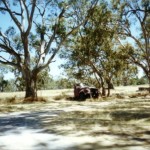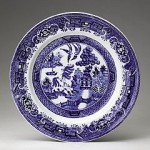On 19 March, at my local Caloundra Family History Research group I attended a talk by guest speaker – Dr Jonathan Prangnell, Senior Lecturer (Archaeology), University of Queensland . The topic was Archaeological Ceramics Excavated in S.E. Queensland.
He brought many sample for us to look at found in S.E. Queensland and explained about ceramics generally also.
 Because ceramics became mass produced by machines using industrial processes a few centuries ago and were then shipped all around the world they have became useful for archeological research of places. This is as you can find them occurring just about any places societies have dwelt. By knowing about the ceramics archaeologists can work out dates, socioeconomic statuses, where people may have come from, trading networks and more. Ceramics are material evidence of the presence of humans.
Because ceramics became mass produced by machines using industrial processes a few centuries ago and were then shipped all around the world they have became useful for archeological research of places. This is as you can find them occurring just about any places societies have dwelt. By knowing about the ceramics archaeologists can work out dates, socioeconomic statuses, where people may have come from, trading networks and more. Ceramics are material evidence of the presence of humans.
The big advantage of ceramics over organics is that in nature they survive, even if broken, compared to organic materials like leather.
In digs, it is rare to get complete vessels however he did bring two examples found in SE Queensland. These were pots from China that would have likely held soy and ginger. He said, ceramics often get used until broken unlike bottles which can be thrown away.
 What sort of things can help date a layer in a dig? Plates with back stamps can help date materials. For example most plates produced after 1891 have a country stamped on the back because of law changes in America. Pattern designs help with dating. The willow pattern from the 1790s is still manufactured today so it can confuse us. Sometimes other things are used also to date layers. Dr Prangnell gave a funny example of platform shoes from the 1970s being useful for dating a more modern layer.
What sort of things can help date a layer in a dig? Plates with back stamps can help date materials. For example most plates produced after 1891 have a country stamped on the back because of law changes in America. Pattern designs help with dating. The willow pattern from the 1790s is still manufactured today so it can confuse us. Sometimes other things are used also to date layers. Dr Prangnell gave a funny example of platform shoes from the 1970s being useful for dating a more modern layer.
He then told us about design types such as transfer print developed in the latter part of the 18th century that helped allow mass production. The flow blue style of white earthenware, where the blue glaze is allowed to run outside the print lines so it blurred or “flowed” during the firing process. This was popular in Victorian times. Another was the sponged design, where a sponge dipped in ink and is pressed on the plate or bowl.
Next we learnt about the types of ceramics:
- Earthen ware is cheap, not fire at high temperatures so remains porous and can take up water. For example clay pipes many of which were made in Scotland with designs for the markets they were intended to be shipped.
- Stone ware is heavier, fired at a higher temperatures so not porous. Often used for containers holding items such as liquids as we do not want them to leak.
- Next is porcelain fired at the highest temperature at about 1,200 and 1,400 °C (2,200 and 2,600 °F) and it becomes translucent with a toughness and strenght.
- A special type of porcelain in bone china. It usually contains beef bones. The bones are burned, ground and added to the clay. Some mixes can be up to 50% bone.

Stamp Showing “Bone China and made in “England”
Archeologists use the type of ceramic, the patterns, back stamp and what it is used for to make discoveries about the areas they are digging. Broken pieces still useful and they can use books with shape guides and a chart to measure smaller shards with an edge to find the diameter of the unbroken piece.
Even information like dates a company produced is useful in working out times.
Jon shared his quick methods to categorise ceramics: A tongue will stick to earthen ware as it is porous. A light will shine through porcelain as it is translucent. If neither works it is stone ware.
Do you enjoy talks that are not just about collecting vital records to give you a greater understanding of your ancestors lives?
